 W
WCommercial fishing is the activity of catching fish and other seafood for commercial profit, mostly from wild fisheries. It provides a large quantity of food to many countries around the earth, but those who practice it as an industry must often pursue fish far into the ocean under adverse conditions. Large-scale commercial fishing is also known as industrial fishing. This profession has gained in popularity with the development of shows such as Deadliest Catch, Swords, and Wicked Tuna.
 W
WFishery is the enterprise of raising or harvesting fish and other aquatic life. Commercial fisheries include wild fisheries and fish farms, both in fresh water and the oceans. About 500 million people worldwide are economically dependent on fisheries. 171 million tonnes of fish were produced in 2016, but overfishing is an increasing problem -- causing declines in some populations. Recreational fishing is popular in many locations, particularly North America, Europe, New Zealand, and Australia.
 W
WThe fishing industry includes any industry or activity concerned with taking, culturing, processing, preserving, storing, transporting, marketing or selling fish or fish products. It is defined by the Food and Agriculture Organization as including recreational, subsistence and commercial fishing, and the related harvesting, processing, and marketing sectors. The commercial activity is aimed at the delivery of fish and other seafood products for human consumption or as input factors in other industrial processes. Directly or indirectly, the livelihood of over 500 million people in developing countries depends on fisheries and aquaculture.
 W
WThis is a list of aquatic animals that are harvested commercially in the greatest amounts, listed in order of tonnage per year (2012) by the Food and Agriculture Organization. Species listed here have an annual tonnage in excess of 160,000 tonnes.
 W
WArtisanal fishing consists of various small-scale, low-technology, low-capital, fishing practices undertaken by individual fishing households. Many of these households are of coastal or island ethnic groups. These households make short fishing trips close to the shore. Their produce is usually not processed and is mainly for local consumption. Artisan fishing uses traditional fishing techniques such as rod and tackle, fishing arrows and harpoons, cast nets, and small traditional fishing boats.
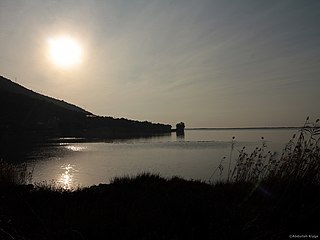 W
WBeymelek Lagoon is a lagoon on the Mediterranean coast, which is used as a fishery, in Antalya Province, southwestern Turkey. It is named after the village of Beymelek, which is located to the west of the water body. It is situated in Demre ilçe (district) of Antalya Province at 36°16′N 30°03′E.
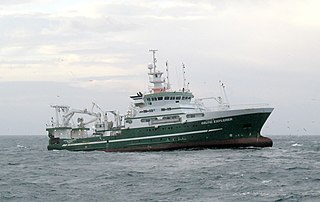 W
WBottom trawling is trawling along the sea floor. It is also referred to as "dragging". The scientific community divides bottom trawling into benthic trawling and demersal trawling. Benthic trawling is towing a net at the very bottom of the ocean and demersal trawling is towing a net just above the benthic zone. Bottom trawling can be contrasted with midwater trawling, where a net is towed higher in the water column. Midwater trawling catches pelagic fish such as anchovies, and mackerel, whereas bottom trawling targets both bottom-living fish (groundfish) and semi-pelagic species such as cod, squid, shrimp, and rockfish.
 W
WAlthough the West Indies has limited resources in terms of developing a large-scale fishing industry, the value of fish and sea products as a source of food has long been recognized. All Caribbean territories therefore have fishing industries.
 W
WClam digging is a North American term for a common way to harvest clams from below the surface of the tidal sand flats or mud flats where they live. It is done both recreationally and commercially. Commercial digging in the U.S. and Canada is colloquially referred to as clamming, and is done by a clammer.
 W
WCod fisheries are fisheries for cod. Cod is the common name for fish of the genus Gadus, belonging to the family Gadidae, and this article is confined to three species that belong to this genus: the Atlantic cod, the Pacific cod and the Greenland cod. Although there is a fourth species of the cod genus Gadus, Alaska pollock, it is commonly not called cod and therefore currently not covered here.
 W
WIn the summer of 1992, when the Northern Cod biomass fell to 1% of earlier levels, the Canadian Federal Minister of Fisheries and Oceans, John Crosbie, declared a moratorium on the Northern Cod fishery, which for the preceding 500 years had primarily shaped the lives and communities of Canada's eastern coast. A significant factor contributing to the depletion of the cod stocks off Newfoundland's shores was the introduction of equipment and technology that increased landed fish volume. From the 1950s onwards, new technology allowed fishers to trawl a larger area, fish more in-depth, and for a longer time. By the 1960s, powerful trawlers equipped with radar, electronic navigation systems, and sonar allowed crews to pursue fish with unparalleled success, and Canadian catches peaked in the late-1970s and early-1980s. Cod stocks were depleted at a faster rate than could be replenished.
 W
WCrab fisheries are fisheries which capture or farm crabs. True crabs make up 20% of all crustaceans caught and farmed worldwide, with about 1.4 million tonnes being consumed annually. The horse crab, Portunus trituberculatus, accounts for one quarter of that total. Other important species include flower crabs, snow crabs (Chionoecetes), blue crabs, edible or brown crabs, Dungeness crab, and mud crabs, each of which provides more than 20,000 tonnes annually.
 W
WDead zones are hypoxic (low-oxygen) areas in the world's oceans and large lakes, which causes these bodies of water to fail to support the aquatic life living there. Historically, many of these sites were naturally occurring. However, in the 1970s, oceanographers began noting increased instances and expanses of dead zones. These occur near inhabited coastlines, where aquatic life is most concentrated.
 W
WDemersal fish, also known as groundfish, live and feed on or near the bottom of seas or lakes. They occupy the sea floors and lake beds, which usually consist of mud, sand, gravel or rocks. In coastal waters they are found on or near the continental shelf, and in deep waters they are found on or near the continental slope or along the continental rise. They are not generally found in the deepest waters, such as abyssal depths or on the abyssal plain, but they can be found around seamounts and islands. The word demersal comes from the Latin demergere, which means to sink.
 W
WDrift netting is a fishing technique where nets, called drift nets, hang vertically in the water column without being anchored to the bottom. The nets are kept vertical in the water by floats attached to a rope along the top of the net and weights attached to another rope along the bottom of the net. Drift nets generally rely on the entanglement properties of loosely affixed netting. Folds of loose netting, much like a window drapery, snag on a fish's tail and fins and wrap the fish up in loose netting as it struggles to escape. However the nets can also function as gill nets if fish are captured when their gills get stuck in the net. The size of the mesh varies depending on the fish being targeted. These nets usually target schools of pelagic fish.
 W
WEating Animals is the third book by the American novelist Jonathan Safran Foer, published in 2009. A New York Times best-seller, Eating Animals provides a dense discussion of what it means to eat animals in an industrialized world. It was written in close collaboration with Farm Forward, a 501(c)(3) nonprofit organization that implements innovative strategies to promote conscientious food choices, reduce farmed animal suffering, and advance sustainable agriculture.
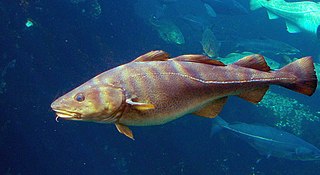 W
WIn European Union member states, there exists a standard set of minimum landing sizes (MLS) for all major species of finfish and shellfish. These MLS are set under EU Council Regulation 850/98.
 W
WAn exclusive economic zone (EEZ), as prescribed by the 1982 United Nations Convention on the Law of the Sea, is an area of the sea in which a sovereign state has special rights regarding the exploration and use of marine resources, including energy production from water and wind. It stretches from the baseline out to 200 nautical miles (nmi) from the coast of the state in question. It is also referred to as a maritime continental margin and, in colloquial usage, may include the continental shelf. The term does not include either the territorial sea or the continental shelf beyond the 200 nautical mile limit. The difference between the territorial sea and the exclusive economic zone is that the first confers full sovereignty over the waters, whereas the second is merely a "sovereign right" which refers to the coastal state's rights below the surface of the sea. The surface waters, as can be seen in the map, are international waters.
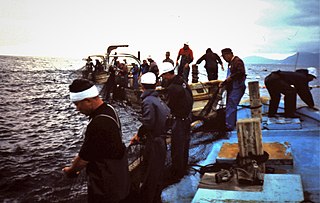 W
WA Fishery cooperative, or fishing co-op, is a cooperative in which the people involved in the fishing industry pool resources, in their certain activities from farming, catching, distribution, and marketing of fish.
 W
WA fishing dredge, also known as a scallop dredge or oyster dredge, is a kind of dredge which is towed along the bottom of the sea by a fishing boat in order to collect a targeted edible bottom-dwelling species. The gear is used to fish for scallops, oysters and other species of clams, crabs, and sea cucumber. The dredge is then winched up into the boat and emptied. Dredges are also used in connection with the work of the naturalist in marine biology, notably on the Challenger Expedition.
 W
WThe fishing industry in Denmark operates around the coastline, from western Jutland to Bornholm. While the overall contribution of the fisheries sector to the country's economy is only about 0.5 percent, Denmark is ranked fifth in the world in exports of fish and fish products. Approximately 20,000 Danish people are employed in fishing, aquaculture, and related industries.
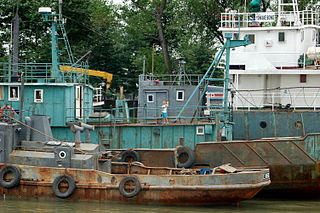 W
WFishing industry in North Korea provides an important supplement to the diet and for export. The catch in 2001 totaled 200,000 tons of wild-caught seafood and 63,700 tons produced using aquaculture. The major fishing grounds are in the coastal areas of the Sea of Japan to the east and the Yellow Sea to the west. The main fishery ports are Sinpo, Kimchaek, and the nearby deep-sea fishery bases of Yanghwa and Hongwfin. The principal catch from the Sea of Japan is pollock.
 W
WForage fish, also called prey fish or bait fish, are small pelagic fish which are preyed on by larger predators for food. Predators include other larger fish, seabirds and marine mammals. Typical ocean forage fish feed near the base of the food chain on plankton, often by filter feeding. They include particularly fishes of the family Clupeidae, but also other small fish, including halfbeaks, silversides, smelt such as capelin and goldband fusiliers.
 W
WFour Fish: The Future of the Last Wild Food is a 2010 nonfiction book by author Paul Greenberg. This work explores the state of commercial fishing and aquaculture. Greenberg frames his observations by commenting on the status of four specific fish: cod, salmon, bass, and tuna. Choosing four fish was a decision influenced by author Michael Pollan's selection of four plants in his book, The Botany of Desire.
 W
WA harmful algal bloom (HAB) contains organisms that can severely lower oxygen levels in natural waters, killing organisms in marine or fresh waters. Some HABs are associated with algae-produced toxins. Blooms can last from a few days to many months. After the bloom dies, the microbes which decompose the dead algae use up even more of the oxygen, which can create fish die-offs. When these zones of depleted oxygen cover a large area for an extended period of time neither fish nor plants are able to survive.
 W
WThe International Fisheries Exhibition was a Victorian era scientific, cultural, and animal exhibition open in South Kensington, London, United Kingdom, between May 12 and October 31, 1883. One of many world's fairs that took place in the second half of the nineteenth century, the exhibition was the largest special event held in the world to that point, attracting 2.6 million visitors, an average of 18,545 per day. The grounds of the exhibition encompassed 21 acres (0.085 km2) of the Royal Horticultural Society grounds in South Kensington, site of the 1862 International Exhibition. Many of the exhibitions on display were based upon the Buckland Museum of Economic Fish Culture, a private collection at South Kensington, and were expanded upon by exhibits from thirty-one countries and colonies. The exhibition attracted attention not only for the variety of fish species and fishing equipment on display, but also for technological achievements such as the widespread use of electric lighting.
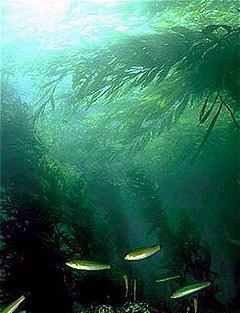 W
WKelp forests are under water areas with a high density of kelp, which covers a large part of the world's coastlines. They are recognized as one of the most productive and dynamic ecosystems on Earth. Smaller areas of anchored kelp are called kelp beds. Kelp forests occur worldwide throughout temperate and polar coastal oceans. In 2007, kelp forests were also discovered in tropical waters near Ecuador. In context, algal kelp forest combined with coral reefs account for less than 1% of global primary productivity.
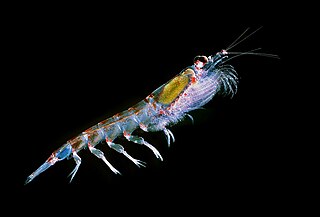 W
WThe krill fishery is the commercial fishery of krill, small shrimp-like marine animals that live in the oceans world-wide. The present estimate for the biomass of Antarctic krill is 379 million tonnes. The total global harvest of krill from all fisheries amounts to 150–200,000 tonnes annually, mainly Antarctic krill and North Pacific krill.
 W
WLobsters are widely fished around the world for their meat. They are often hard to catch in large numbers, but their large size can make them a profitable catch. Although the majority of the targeted species are tropical, the majority of the global catch is in temperate waters.
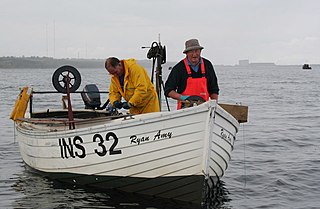 W
WLongline fishing, or longlining, is a commercial fishing technique. It uses a long line, called the main line, with baited hooks attached at intervals by means of branch lines called snoods. A snood is a short length of line, attached to the main line using a clip or swivel, with the hook at the other end. Longlines are classified mainly by where they are placed in the water column. This can be at the surface or at the bottom. Lines can also be set by means of an anchor, or left to drift. Hundreds or even thousands of baited hooks can hang from a single line. Longliners – fishing vessels rigged for longlining – commonly target swordfish, tuna, halibut, sablefish and many other species.
 W
WThe Magnuson-Stevens Act Provisions is necessary to help compliance the requirements of the MSA to end and prevent overfishing, rebuild overfished stocks, and achieve maximum yield
 W
WThe Missolonghi-Aitoliko lagoons complex is located in the north part of the Gulf of Patras in the central west coast of Greece. It is one of the most important Mediterranean lagoons. It is a shallow area of 150 km2, extended between the Acheloos and Evinos rivers. It is protected by the Ramsar Convention and it is also included in the Natura 2000 network.
 W
WThe Beaufort Sea is a marginal sea of the Arctic Ocean, located north of the Northwest Territories, the Yukon, and Alaska, and west of Canada's Arctic islands. The sea is named after Sir Francis Beaufort, a hydrographer. The Mackenzie River, the longest in Canada, empties into the Canadian part of the Beaufort Sea west of Tuktoyaktuk, which is one of the few permanent settlements on the sea's shores.
 W
WOily fish are fish species with oil in soft tissues and in the coelomic cavity around the gut. Their fillets may contain up to 30% oil, although this figure varies both within and between species. Examples of oily fish include small forage fish such as sardines, herring and anchovies, and other larger pelagic fish such as salmon, trout, tuna, swordfish and mackerel.
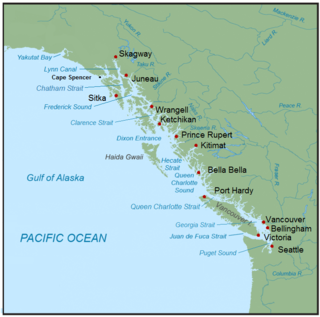 W
WThe Pacific Salmon War was a period of heightened tensions between Canada and the United States over the Pacific Salmon catch. It began in 1992 after the first Pacific Salmon Treaty, which had been ratified in 1985, expired, and lasted until a new agreement was signed in 1999. Disagreements were high in 1994, when a transit fee was set on American fishing vessels using the Inside Passage and a ferry was blockaded by fishing boats in Friday Harbor, Washington.
 W
WPair trawling is a fishing activity carried out by two boats, with one towing each warp. As the mouth of the net is kept open by the lateral pull of the individual vessels, otter boards are not required. With the towing power of two boats and no otter boards, a larger net may be worked than would otherwise be possible, or alternatively, the two boats can share increased fuel efficiency.
 W
WPelagic fish live in the pelagic zone of ocean or lake waters – being neither close to the bottom nor near the shore – in contrast with demersal fish that do live on or near the bottom, and reef fish that are associated with coral reefs.
 W
WThe San Leandro Oyster Beds in San Leandro, California, were the origin of the oyster industry in the U.S. state of California. During the 1890s, the oyster industry thrived until it became the single most important fishery in the state. According to the description provided by the California Office of Historic Preservation, Moses Wicks is supposed to have been the first to bring seed oysters around Cape Horn and implant them in the San Leandro beds. The oyster industry in San Francisco Bay was at its height around the turn of the 20th century. It reached a secondary peak by 1911 and then faded away because of polluted conditions of the bay.
 W
WIt is a central tenet of the EU maritime policy that all seas have a particular nature, defined by their geography, their ecology, their economies and their people. Most seas are nested and do not, except for specific purposes such as hydrography or fisheries management, have sharp, recognised boundaries. One important sea for purposes of fisheries management is referred to as the "seas West of Scotland". In line with the EU maritime policy, the sea does not only encompass the waters but also the people and economy of the areas bordering that sea.
 W
WSeine fishing is a method of fishing that employs a fishing net, called a seine, that hangs vertically in the water with its bottom edge held down by weights and its top edge buoyed by floats. Seine nets can be deployed from the shore as a beach seine, or from a boat.
 W
WThe shrimp fishery is a major global industry, with more than 3.4 million tons caught per year, chiefly in Asia. Rates of bycatch are unusually high for shrimp fishing, with the capture of sea turtles being especially contentious.
 W
WSimilar to a gillnet, the tangle net, or tooth net, is a type of nylon fishing net. Left in the water for no more than two days, and allowing bycatch to be released alive, this net is considered to be less harmful that other nets. The tangle net is used in the Philippines by commercial fishermen, as well as by the scientific community. When spent, these nets can be bundled, and left on the sea floor to collect smaller species. These bundles are known locally as lumen lumen nets.
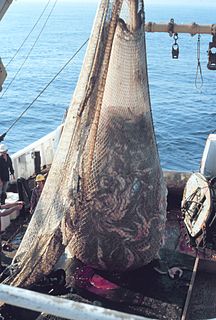 W
WTrawling is a method of fishing that involves pulling a fishing net through the water behind one or more boats. The net used for trawling is called a trawl. This principle requires netting bags which are towed through water to catch different species of fishes or sometimes targeted species. Trawls are often called towed gear or dragged gear.
 W
WUnsustainable fishing methods refers to the utilization of the various fishing methods in order to capture or harvest fish, at a rate which sees the declining of fish populations over time. These methods are observed to facilitate the destructive fishing practices that destroy ecosystems within the ocean, and is used as a tool for over-fishing which results in the depletion of fish populations at a rate that cannot be sustained.
 W
WVessel Monitoring Systems (VMS) is a general term to describe systems that are used in commercial fishing to allow environmental and fisheries regulatory organizations to track and monitor the activities of fishing vessels. They are a key part of monitoring control and surveillance (MCS) programs at national and international levels. VMS may be used to monitor vessels in the territorial waters of a country or a subdivision of a country, or in the Exclusive Economic Zones (EEZ) that extend 200 nautical miles (370.4 km) from the coasts of many countries. VMS systems are used to improve the management and sustainability of the marine environment, through ensuring proper fishing practices and the prevention of illegal fishing, and thus protect and enhance the livelihoods of fishermen.
 W
WWhitefish or white fish is a fisheries term for several species of demersal fish with fins, particularly Atlantic cod, whiting, haddock, hake (Urophycis), pollock (Pollachius), and others. Whitefish (Coregonidae) is also the name of several species of Atlantic freshwater fish.
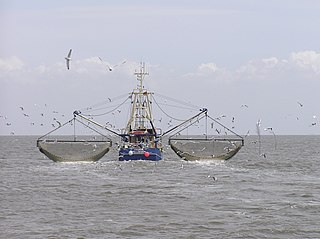 W
WA fishery is an area with an associated fish or aquatic population which is harvested for its commercial value. Fisheries can be marine (saltwater) or freshwater. They can also be wild or farmed.
 W
WThe global commercial production for human use of fish and other aquatic organisms occurs in two ways: they are either captured wild by commercial fishing or they are cultivated and harvested using aquacultural and farming techniques.